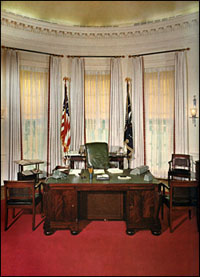june  2009
2009
I spent this past weekend totally absorbed in the book Whale Warriors: The Battle at the Bottom of the World to Save the Planet's Largest Mammals by Peter Heller. The story's protagonist, the larger than life Paul Watson, is my new hero.
"Our intention is to stop the criminal whaling. We are not a protest organization. We are here to enforce international conservation law. We don't wave banners. We intervene." — Captain Paul Watson, Sea Shepherd Conservation Society founder
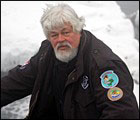 Paul Watson was one of the founding members of Greenpeace in 1972 but he parted ways with the organization in 1977 when his personal philosophy, partially summed up in the quote above, put him at odds with the protest organization's new leadership. That same year, he founded the Sea Shepherd Conservation Society, an organization whose mission is to pick up where Greenpeace leaves off. They go after people and governments engaged in the illegal slaughter of endangered animals, not to bear witness like Greenpeace — whose members must draw the line at hanging banners and harassment with bullhorns — but to do whatever it takes to stop the killing.
Paul Watson was one of the founding members of Greenpeace in 1972 but he parted ways with the organization in 1977 when his personal philosophy, partially summed up in the quote above, put him at odds with the protest organization's new leadership. That same year, he founded the Sea Shepherd Conservation Society, an organization whose mission is to pick up where Greenpeace leaves off. They go after people and governments engaged in the illegal slaughter of endangered animals, not to bear witness like Greenpeace — whose members must draw the line at hanging banners and harassment with bullhorns — but to do whatever it takes to stop the killing.
"Whaling fleets around the world know he means business. Watson has sunk eight whaling ships. He has rammed numerous illegal fishing vessels on the high seas. By 1980 he had single-handedly shut down pirate whaling in the North Atlantic by sinking the notorious pirate whaler Sierra in Portugal and three of Norway's whaling fleet at dockside... To his critics he points out that he has never hurt anyone, and that he has never been convicted of a felony in any country." [Excerpt from The Whale Warriors, Peter Heller]
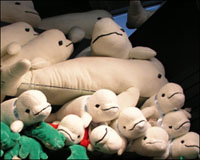 Having spent many of my formative years in Seattle in the late 70s and early 80s, I remember when French agents sank the Rainbow Warrior in preemptive retaliation for Greenpeace's protest of their underground nuclear tests. I grew up in a household that sent donations to the World Wildlife Fund every year and I have vivid memories of Save the Whales posters adorning the walls of all the coffee shops and co-op health food stores my parents and I frequented on the weekends. I even had a stuffed seal and a baby Beluga from the Seattle Aquarium that shared space on my toy shelf beside Malibu Barbie and Western Ken.
Having spent many of my formative years in Seattle in the late 70s and early 80s, I remember when French agents sank the Rainbow Warrior in preemptive retaliation for Greenpeace's protest of their underground nuclear tests. I grew up in a household that sent donations to the World Wildlife Fund every year and I have vivid memories of Save the Whales posters adorning the walls of all the coffee shops and co-op health food stores my parents and I frequented on the weekends. I even had a stuffed seal and a baby Beluga from the Seattle Aquarium that shared space on my toy shelf beside Malibu Barbie and Western Ken.
Regardless of the fact that my upbringing should have led me to expect nothing less, I still find it amazing — inspiring, electrifying and edifying — that someone like Paul Watson can exist today, against all odds and obstacles, to say nothing of unrelenting opposition from those who should be on his side, those for whom three decades of entropy and economics have corrupted, diluted and eroded away all the activist ideals that once united them.
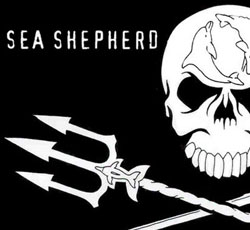 Members of Watson's generation were inspired by revelations brought to public attention by people like Farley Mowat, Rachel Carson and Jacques Cousteau. Riding the wave that started with the Civil Rights movement and anti-war demonstrations, they were mobilized by their outrage to protest the atrocities they saw being done to the world around them. In the wake of the environmental movements started in the 1960s, organizations like Greenpeace and Earth First were established and critical pieces of legislation like the Clean Air and Clean Water Acts and the Endangered Species Act were passed (thanks to Ralph Nader among others).
Members of Watson's generation were inspired by revelations brought to public attention by people like Farley Mowat, Rachel Carson and Jacques Cousteau. Riding the wave that started with the Civil Rights movement and anti-war demonstrations, they were mobilized by their outrage to protest the atrocities they saw being done to the world around them. In the wake of the environmental movements started in the 1960s, organizations like Greenpeace and Earth First were established and critical pieces of legislation like the Clean Air and Clean Water Acts and the Endangered Species Act were passed (thanks to Ralph Nader among others).
I first heard about Paul Watson last year on a podcast interview with Peter Heller. I was intrigued and I remember searching for more information but, finding little in the form of instantly gratifying audio or video, I almost forgot about it until a few weeks ago. I was on Skype with my mother and she mentioned that she had caught an episode of this amazing TV show. When I found it on the Animal Planet web site I starting babbling gratefully — oh my god, that's the guy — and telling her how I knew about him. We agreed that he looks like the spirit of the great polar bear in human form. Then last week, by complete coincidence, I discovered the audio book at the library.
The story is of Peter Heller's three-month journey with Watson and the Sea Shepherd's nearly all-volunteer crew of beyond dedicated activists from around the world; coming from backgrounds as different as you can imagine, they are united in their willingness, if necessary, to die for the mission — an emphatically non rhetorical statement, considering how often that commitment is put to the test on any given mission. Their allegiance is something the captain takes for granted, though never lightly, as they set out for the icy, unforgiving waters of the Southern Ocean — waters that, incidentally, have been protected, albeit by words only, since 1986 when a UN mandate declared the area a marine mammal sanctuary and therefore off-limits to commercial whalers. The Japanese fleet has circumvented this, if only in their own minds, by spinning the hunt as "marine research" that gives them license to kill around 1,000 whales, endangered species and non (or not yet), every year.
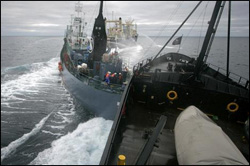 Sea Shepherd's interventionist tactics have caused some governments to label them pirates, criminals and even domestic terrorists but, as Watson says, they are in fact engaged in international law enforcement. All they are doing is upholding a UN mandate that no one else seems to want to take action to enforce. Besides, destruction of property is not the same as violence — and it's not even against the law if the property in question is engaged in the commission of a crime.
Sea Shepherd's interventionist tactics have caused some governments to label them pirates, criminals and even domestic terrorists but, as Watson says, they are in fact engaged in international law enforcement. All they are doing is upholding a UN mandate that no one else seems to want to take action to enforce. Besides, destruction of property is not the same as violence — and it's not even against the law if the property in question is engaged in the commission of a crime.
I won't be spoiling any surprises here if I mention my favorite tool of law enforcement used by the crew against the whaling ships, that being the "can opener," a modified length of I-beam extended from the side of the ship. It can inflict catastrophic damage when their vessel is forced to ram a whaling ship. (Right — how completely badass is that??)
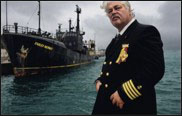 Since the publication of The Whale Warriors in 2007 the SSCS has enjoyed a surge in publicity, most of it positive and the rest — well, there's no such thing as bad publicity, right? The award-winning documentary Sharkwater was released in 2008 as well as Whale Wars, a reality-TV style show on Animal Planet that follows the crew to the Antarctic on their mission to stop the Japanese fleet of "research whalers" from killing their self-proclaimed season quota of 1,000 whales. The second season premiered earlier this month.
Since the publication of The Whale Warriors in 2007 the SSCS has enjoyed a surge in publicity, most of it positive and the rest — well, there's no such thing as bad publicity, right? The award-winning documentary Sharkwater was released in 2008 as well as Whale Wars, a reality-TV style show on Animal Planet that follows the crew to the Antarctic on their mission to stop the Japanese fleet of "research whalers" from killing their self-proclaimed season quota of 1,000 whales. The second season premiered earlier this month.
The Sea Shepherd Society web site has a page full of suggestions for "onshore volunteers" as well as an application form you can download and send in if you want to join the crew. After reading the book, watching the campaign videos and listening to interviews all weekend, I have to say the US Army's recruiters could learn a thing or two from Sea Shepherd.
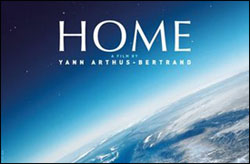 Another environmental hero, whose approach could almost be considered (heh) the polar opposite of Paul Watson's, is Yann Arthus-Bertrand, a French photographer who has recently become world-renowned for his astonishing aerial images of 101 nations as seen from above. He offers wallpaper-resolution downloads of all of them on his web site.
Another environmental hero, whose approach could almost be considered (heh) the polar opposite of Paul Watson's, is Yann Arthus-Bertrand, a French photographer who has recently become world-renowned for his astonishing aerial images of 101 nations as seen from above. He offers wallpaper-resolution downloads of all of them on his web site.
I've been a fan of his stunningly original images since last year when the Boston Globe featured some of his photos from around the world but I'd heard nothing about his documentary film debut until its release on June 5, 2009 when my friend sent me the link.
HOME, which Bertrand has posted online as a gift to the world, is an environmental masterpiece. In presenting the world as he and few others ever see it — from above — he gives viewers a unique perspective, one that makes it impossible to go on ignoring the evidence that we are swiftly destroying ourselves. The story is depressing, yes, but like Baraka, the only other Earth epic I would compare it to, the cinematography is so insanely beautiful, even when lingering over scenes of devastation, it's almost enough to distract you from the apocalyptic narrative it illustrates.
 The film is available free on Youtube and you can find details about how it was filmed and funded at the official HOME web site. You can also subscribe to the homeproject channel on youtube where the film is available in multiple languages along with many behind the scenes videos and interviews.
The film is available free on Youtube and you can find details about how it was filmed and funded at the official HOME web site. You can also subscribe to the homeproject channel on youtube where the film is available in multiple languages along with many behind the scenes videos and interviews.
"We are living in exceptional times. Scientists tell us that we have 10 years to change the way we live, avert the depletion of natural resources and the catastrophic evolution of the Earth's climate. The stakes are high for us and our children. Everyone should take part in the effort, and HOME has been conceived to take a message of mobilization out to every human being. For this purpose, HOME needs to be free. A patron, the PPR Group, made this possible. EuropaCorp, the distributor, also pledged not to make any profit because Home is a non-profit film. HOME has been made for you: share it! And act for the planet." — Yann Arthus-Bertrand, GoodPlanet Foundation President
 Watching HOME, I made two odd personal observations; one was a coincidental discovery that answered a question I had feared I might never have answered. I was Google-mapping something in Washington state a few weeks back when I found myself drifting eastward into the dubious regions surrounding the Hanford nuclear site. The satellite imagery showed vast swaths of desert land (oddly, I thought) divided by long, straight throughways with names like Government Road, etc. I found myself, quite unwittingly at first, lured down a veritable maze — a Habitrail, if you will — of sites about federal land leases and military bases in Washington (fyi, the federal government currently owns 30% of the state).
Watching HOME, I made two odd personal observations; one was a coincidental discovery that answered a question I had feared I might never have answered. I was Google-mapping something in Washington state a few weeks back when I found myself drifting eastward into the dubious regions surrounding the Hanford nuclear site. The satellite imagery showed vast swaths of desert land (oddly, I thought) divided by long, straight throughways with names like Government Road, etc. I found myself, quite unwittingly at first, lured down a veritable maze — a Habitrail, if you will — of sites about federal land leases and military bases in Washington (fyi, the federal government currently owns 30% of the state).
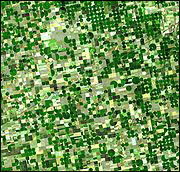 Then I spotted something new — new to me, new to my mother, whose initial email about some town in southwestern Washington state had been the (also unwitting) catalyst to this wild goose chase, and new to Mr. Pink (whose only comment, besides a somewhat distracted, yeah, that is kinda weird, was "you really shouldn't sit all hunched over like that"). As I scrolled north from Hanford, leaving behind miles of barren wasteland, apparently ideal for testing the latest fighter jets and god-knows-what-else, I observed that the arid landscape was suddenly dotted with circular plots of verdant green, thousands of them, blooming out of the dry expanse of eastern Washington in a kaleidoscope of emerald and jade.
Then I spotted something new — new to me, new to my mother, whose initial email about some town in southwestern Washington state had been the (also unwitting) catalyst to this wild goose chase, and new to Mr. Pink (whose only comment, besides a somewhat distracted, yeah, that is kinda weird, was "you really shouldn't sit all hunched over like that"). As I scrolled north from Hanford, leaving behind miles of barren wasteland, apparently ideal for testing the latest fighter jets and god-knows-what-else, I observed that the arid landscape was suddenly dotted with circular plots of verdant green, thousands of them, blooming out of the dry expanse of eastern Washington in a kaleidoscope of emerald and jade.
After 45 minutes of searching, I gave up. I couldn't figure it out and I was irritated enough to convince myself I didn't care if I ever knew what those mystifyingly perfect crop circles were. Then, halfway through watching HOME, there was the answer; they are fossil water irrigation systems for carrying groundwater to crops and the irrigation array that sweeps the crops is what lends them their improbable geometric perfection. In the film, the example is Qatar, where this method of irrigation is extremely destructive, using up non-renewable underground water reserves as quickly as possible and leaving behind a desert dotted with dead, dried-up crop circles.
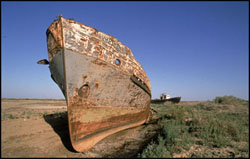 My friend has a tongue-in-cheek theory that the endgame of human existence is to cover the entire globe with concrete. I was reminded of that as I watched the scenes over Hong Kong and New York (no disrespect — I mean, the globe should be so lucky, right?). It also reminded me of this comic strip from Heavy Metal magazine a while back where the futuristic earth was seen floating against the stars, a spiky grey armored ball — no visible oceans or borders, every square inch covered with skyscrapers, satellite towers and gun turrets reaching up into the sky.
My friend has a tongue-in-cheek theory that the endgame of human existence is to cover the entire globe with concrete. I was reminded of that as I watched the scenes over Hong Kong and New York (no disrespect — I mean, the globe should be so lucky, right?). It also reminded me of this comic strip from Heavy Metal magazine a while back where the futuristic earth was seen floating against the stars, a spiky grey armored ball — no visible oceans or borders, every square inch covered with skyscrapers, satellite towers and gun turrets reaching up into the sky.
Then there are places like Madagascar where deforestation and land erosion have resulted in a surreal landscape where thin rivers stained red with sediment run-off snake between barren plateaus, clear-cut and exposed to the sun like slabs of raw meat. This is the stage right before desertification, which occurs when all the loose topsoil is washed or blown away by rain and wind before anything with roots has the chance to take hold again.
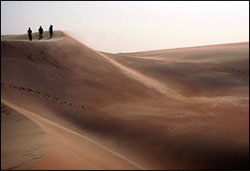 Finally, you have places like the Aral Sea, now being called "the world's youngest desert," and Mauritania which looks unsettlingly like the surface of Mars. That was when the second thought hit me. It's like that hypothesis Richard Carrier uses to refute the existence of god; if there were a god, the universe would be set up with conditions ideal for creating and sustaining life but, Earth aside, the universe actually seems to be ideally suited to the creation of black holes.
Finally, you have places like the Aral Sea, now being called "the world's youngest desert," and Mauritania which looks unsettlingly like the surface of Mars. That was when the second thought hit me. It's like that hypothesis Richard Carrier uses to refute the existence of god; if there were a god, the universe would be set up with conditions ideal for creating and sustaining life but, Earth aside, the universe actually seems to be ideally suited to the creation of black holes.
So maybe humanity isn't the virus-run-amok we appear to be — maybe we are just uniquely and perfectly evolved for the task of creating deserts. First (heh) Mars and now Earth. Or maybe it's like the plot of Brewster's Millions on a planetary scale and we're supposed to burn through the resources, strip the vegetation, kill all the other species, exhaust the water table and reduce all the viable land to poisoned dust — only then will we get our real prize, a brand-new, untouched planet 20 times the size of Earth and teeming with delicious life.
Something occurred to me for the first time yesterday that in retrospect really could have, perhaps should have, a long time ago. The fact that it hadn't is either a testament to my upbringing and citizenship in two countries that aggressively endorse the sanctity of free speech — or an illustration of enduring (maybe endearing) naivety on my part.
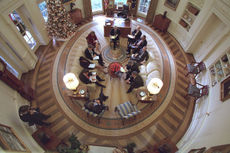 I was watching clips from MSNBC's two-hour Live from the West Wing special which aired earlier this week. As their TV cameras navigated a maze of narrow corridors and security-guarded doorways through the White House, two thoughts distracted me from Brian Williams' effusive commentary. The first should be obvious to anyone who's known me for more than three years; damn, the set designers on The West Wing really nailed it. (Incidentally, Rahm Emanuel would have blended so seamlessly into the cast it's almost hard to take him seriously in the role of the guy who keeps closing his door and turning his back on the camera crew.)
I was watching clips from MSNBC's two-hour Live from the West Wing special which aired earlier this week. As their TV cameras navigated a maze of narrow corridors and security-guarded doorways through the White House, two thoughts distracted me from Brian Williams' effusive commentary. The first should be obvious to anyone who's known me for more than three years; damn, the set designers on The West Wing really nailed it. (Incidentally, Rahm Emanuel would have blended so seamlessly into the cast it's almost hard to take him seriously in the role of the guy who keeps closing his door and turning his back on the camera crew.)
The second thing occurred to me as the cameras rolled into the Oval Office to film the arrivals and pleasantries preceding the President's daily briefing. As they panned around the room, the meeting got underway and the cameras lingered on iconic set pieces like the giant Presidential seal-emblazoned rug and historic desk donated by Queen Victoria in 1880 during the Hayes administration. (It was built from the timbers of the British frigate HMS Resolute — strangely, I could find no mention of what kind of wood it's made of.) But all this time, what I could not stop thinking about was how many god damn windows there are behind that desk — three, to be precise — three huge, soaring, presently undraped floor-to-ceiling windows — right behind his head.
Of course my first impulse was to google it — then I stopped and thought about it. What search terms would I use? "Oval office, bulletproof, windows?" Yeah, right. "Oval office, security specifications, glass thickness?" You can see my conundrum. So I let it go. Paranoia trumps curiosity? I guess I weighed the options and decided there are some things I don't really need to know (even if the information wants to be free).
I wrote an article about online privacy for The Vancouver Sun in 2000 — in the form of a question that has since been definitively answered. As is so often the case, The Last Psychiatrist lays out the really disturbing questions in his article, What Hath Google Wrought." Here's an excerpt:
"Imagine the post office copied every letter it handled, and could cross reference the contents of those letters with other databases: calendar; credit card/online purchases, physical location, etc. Scary? Now imagine that the post office housed those databases...
Let's say Google goes out of business. Who gets all those servers? All that data? Who gets a copy of the world, on the cheap? Whoever it is doesn't have to give us satellite photos anymore. What can you do with satellite photos that no one else has? Who gets to decide how to control all that data?" [What Hath Google Wrought, The Last Psychiatrist]
If you really want to go down the rabbit hole, check out Steve Rambam's lecture (all three hours of it) Privacy is Dead — Get over it.
It's interesting how one brilliant idea can take hold so quickly and completely and sweep up everything it touches in the magnetic awesomeness of its initial promise that, when it's taken to its logical extreme, it doesn't assimilate like a normal idea. It circumvents the evolution process and implodes on itself, utterly annihilating the original kernel of genius and taking down a whole lot of other shit with it.
Your idea becomes a product so good it becomes a brand, so ubiquitous it becomes a monopoly (and no one cares — all your competitors go back to the drawing board). You become a household word — a verb — that's everywhere we want to be. And you can see us, all of us, all the time and everywhere in the whole wide world. We tell you everything (or might as well) and it's so easy, we can't imagine where we'd be without you (no one remembers life before you — but we can look it up if we need to). You know what we're thinking and what we're doing, who we look like and who we're looking for, how we walk, who we talk to — do we trust you? We don't need to — you know us better than we know ourselves. And it kinda goes without saying that the verb that owns all the information in the world knows when we've been bad or good — but nobody minds. After all, what (or maybe I should say, where) have we got to hide?
At WhiteHouseMuseum.org you can see historical photos and an itemized timeline of every Oval Office redecoration performed under every President since 1909. Compare the tastes of 13 US Presidents (or their wives' decorators') and learn fun facts like which two presidents chose not to change the decor.
One thing you will not learn is anything about those god damn windows.
[Red room... red room... The Oval Office was completely redecorated in November 1963 while the Kennedys were in Dallas.]
